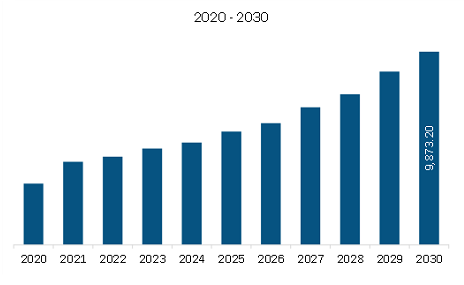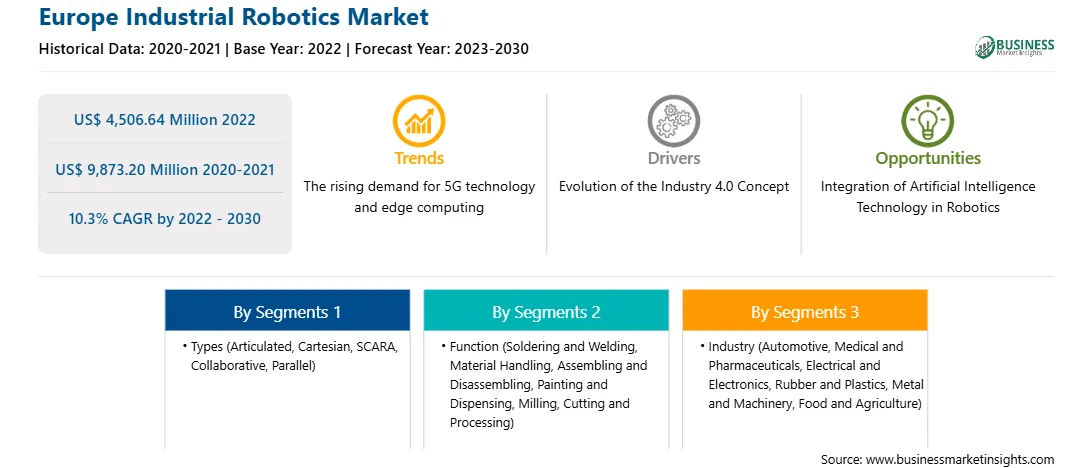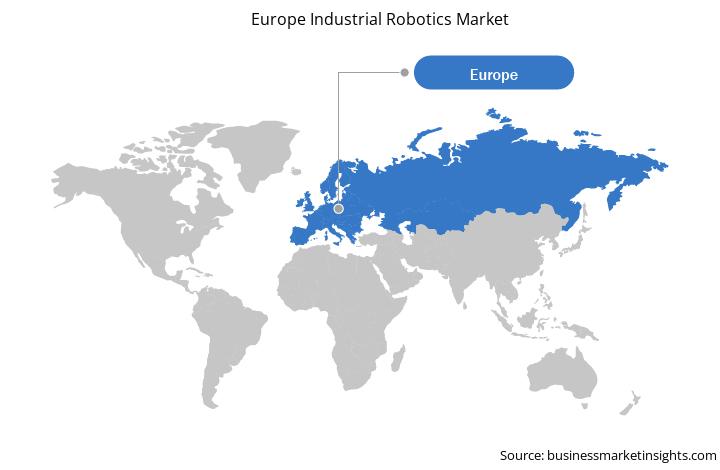Sustainability and environmental considerations are anticipated to be vital trends in the Europe industrial robotics market. Industrial robots are being designed to be more energy efficient with improved power management systems and energy-saving features. In coming years, the robotics sector will focus on developing energy-efficient robots that would help companies lower their carbon footprint and achieve sustainability goals. Industrial robots can also improve material efficiency, optimize processes, and reduce waste. Additionally, advancements in recycling robot components and materials can reduce the industry's environmental impact. Industrial robotics are expected to involve green manufacturing practices to reduce the use of hazardous substances and minimize emissions. Manufacturers would be able to explore the usage of eco-friendly materials and sustainable design principles by introducing industrial robots. This will include selecting materials with lower environmental impact. By embracing sustainability and environmental considerations, the Europe industrial robotics market can contribute to a more sustainable manufacturing sector. These above-mentioned future trends will drive the development of more environment friendly robotics systems aligning with global efforts toward a greener and more sustainable future.
The Europe industrial robotics market is segmented into Germany, France, the UK, Italy, Spain, Sweden, Belgium, the Netherlands, and the Rest of Europe. In European Union, Germany is a highly automated economy. In 2020, the country had ~230,000 industrial robots. In 2020 alone, manufacturing facilities in Germany installed 22,300 new industrial robots. According to the International Federation of Robotics (IFR), Germany accounts for 33% of overall Europe's robot inventory. The number of robots in German manufacturing facilities is more than three times compared to Italy, which has 78,200 industrial robots. Similarly, in 2020, France had ~44,800 industrial robots, whereas the UK accounted for 23,000 industrial robots. The growing use of robots in manufacturing, alongside humans, is easing manufacturing operations and increasing production volume. Thus, the manufacturing facilities across the region are constantly eyeing on adopting newer, technologically advanced robotic solutions. This parameter is a key driving force in the Europe industrial robotics market in Europe. The digital industrial revolution, i.e., Industry 4.0, is helping increase operational flexibility in manufacturing sector for mass customization, increased speed of workflows, better quality of final products, and improved productivity in factories. According to IFR, the total installation of industrial robots across the region increased by 15% in 2021 compared to 2020. Because of this, automotives chemicals, food & beverages, mechanical engineering, and electronics sectors are installing industrial robots to increase productivity. In 2021, the installation of industrial robot installations in Europe regained growth after two years of decline due to the rising demand from various industrial sectors. For instance, in 2021, the installation of industrial robots in metal & machinery and plastics & chemical products rose strongly by 50% and 30%, respectively, compared to 2018. Thus, the rising adoption of automation solutions further boosts the Europe industrial robotics market growth. Governments of various countries are investing in automating the manufacturing business in the region. For instance, in July 2021, the government of the UK announced an investment of US$ 59.3 million (GBP 53 million) to drive the development of digital manufacturing technologies. Out of which, US$ 28.10 million (GBP 25 million) will be invested in setting up five new industry-sponsored research centers to accelerate the development of cutting-edge digital solutions that can transform manufacturing businesses. The remaining amount will be invested in a digital supply chain innovation hub and provided to 37 individual projects to digitalize and transform manufacturing supply chains. Thus, the growing government support to boost automation will further boost the growth of the Europe industrial robotics market.
Strategic insights for the Europe Industrial Robotics provides data-driven analysis of the industry landscape, including current trends, key players, and regional nuances. These insights offer actionable recommendations, enabling readers to differentiate themselves from competitors by identifying untapped segments or developing unique value propositions. Leveraging data analytics, these insights help industry players anticipate the market shifts, whether investors, manufacturers, or other stakeholders. A future-oriented perspective is essential, helping stakeholders anticipate market shifts and position themselves for long-term success in this dynamic region. Ultimately, effective strategic insights empower readers to make informed decisions that drive profitability and achieve their business objectives within the market. The geographic scope of the Europe Industrial Robotics refers to the specific areas in which a business operates and competes. Understanding local distinctions, such as diverse consumer preferences (e.g., demand for specific plug types or battery backup durations), varying economic conditions, and regulatory environments, is crucial for tailoring strategies to specific markets. Businesses can expand their reach by identifying underserved areas or adapting their offerings to meet local demands. A clear market focus allows for more effective resource allocation, targeted marketing campaigns, and better positioning against local competitors, ultimately driving growth in those targeted areas.
Europe Industrial Robotics Strategic Insights

Europe Industrial Robotics Report Scope
Report Attribute
Details
Market size in 2022
US$ 4,506.64 Million
Market Size by 2030
US$ 9,873.20 Million
Global CAGR (2022 - 2030)
10.3%
Historical Data
2020-2021
Forecast period
2023-2030
Segments Covered
By Types
By Function
By Industry
Regions and Countries Covered
Europe
Market leaders and key company profiles
Europe Industrial Robotics Regional Insights

Europe Industrial Robotics Market Segmentation
The Europe industrial robotics market is segmented into types, function, industry, and country.
Based on types, the Europe industrial robotics market is segmented into articulated, cartesian, SCARA, collaborative, parallel, and others. In 2022, the articulated segment registered the largest share in the Europe industrial robotics market.
Based on function, the Europe industrial robotics market is segmented into soldering and welding, material handling, assembling and disassembling, painting and dispensing, milling, and cutting and processing. In 2022, the soldering and welding segment registered the largest share in the Europe industrial robotics market.
Based on industry, the Europe industrial robotics market is segmented into automotive, medical and pharmaceuticals, electrical and electronics, rubber and plastics, metal and machinery, and food and agriculture. In 2022, the automotive segment registered the largest share in the Europe industrial robotics market.
Based on country, the Europe industrial robotics market is segmented into Germany, France, Italy, Spain, the UK, Sweden, Belgium, Netherlands, and the Rest of Europe. In 2022, Germany registered the largest share in the Europe industrial robotics market.
ABB Ltd, Comau SpA, Fanuc Corp, Kawasaki Heavy Industries Ltd, Kuka AG, Mitsubishi Electric Corp, Seiko Epson Corp, Staubli International AG, Universal Robots AS, and Yaskawa Electric Corp are some of the leading companies operating in the Europe industrial robotics market.
The Europe Industrial Robotics Market is valued at US$ 4,506.64 Million in 2022, it is projected to reach US$ 9,873.20 Million by 2030.
As per our report Europe Industrial Robotics Market, the market size is valued at US$ 4,506.64 Million in 2022, projecting it to reach US$ 9,873.20 Million by 2030. This translates to a CAGR of approximately 10.3% during the forecast period.
The Europe Industrial Robotics Market report typically cover these key segments-
The historic period, base year, and forecast period can vary slightly depending on the specific market research report. However, for the Europe Industrial Robotics Market report:
The Europe Industrial Robotics Market is populated by several key players, each contributing to its growth and innovation. Some of the major players include:
The Europe Industrial Robotics Market report is valuable for diverse stakeholders, including:
Essentially, anyone involved in or considering involvement in the Europe Industrial Robotics Market value chain can benefit from the information contained in a comprehensive market report.